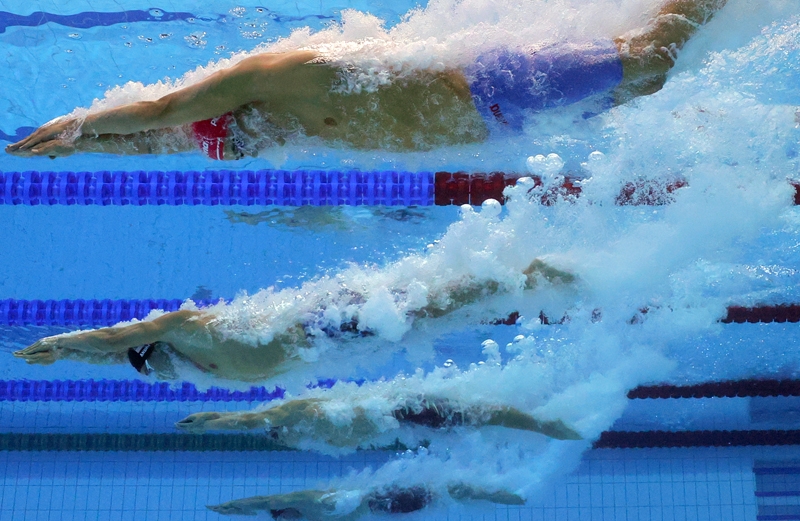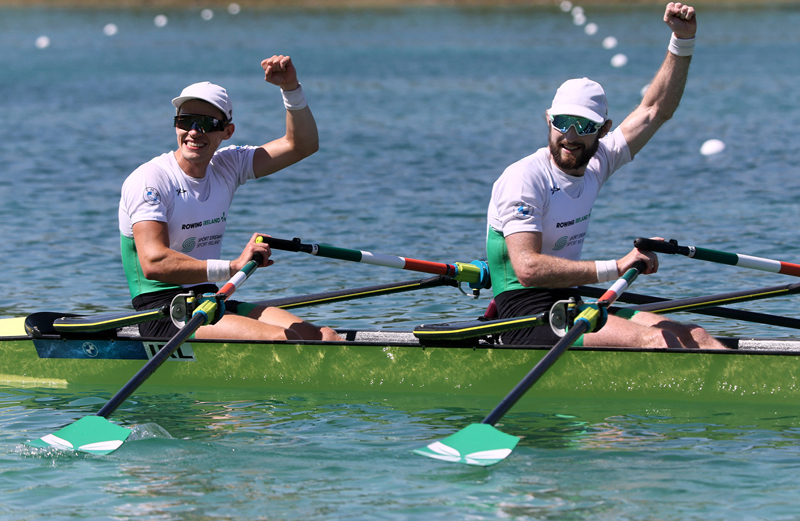Swimming performance: time to flex those ankles

SPB looks at new research on ankle flexibility and its impact on swim-start performance
Although fitness and stroke technique are key determinants of swimming performance, there’s another aspect - and one which is often overlooked – which is the swim start. The start time from the blocks to the 15-metre mark (roughly point where swimmers get into their stroke) can account for anywhere between 0.8% and 26.1% of the total race time, depending on the event(1). In sprint events therefore, this means that over one quarter of the race time can be determined by the efficiency or otherwise of the swim start.Underwater kicking for the win
The all-important swim start consists of the push off the blocks, the flight through the air, the water entry and the glide underwater. Of these four elements, it is the underwater glide that comprises the major component. When entering the water at the start of the glide, the swimmer’s speed will be significantly higher than that during the swim stroking phase, which will form the rest of the race. The goal therefore is to try and capitalise on the initial high speed of the glide phase by minimising (as much as possible) the reduction in speed during the glide through underwater leg kicking.Research looking at underwater kicking compared the propulsive force produced by kicking to the drag-induced losses in velocity caused by moving out of the perfect arrow shape during gliding(2). In this study, researchers compared the following types of underwater kicking:
- A prone streamline glide (no kicking – the control)
- A prone freestyle kick
- A prone dolphin kick
- A lateral dolphin kick
Another more recent study provides useful and practical data as it investigated roughly how far into the glide swimmers should ideally start underwater dolphin kicking(3). Why more useful? Well, distance in the pool is much easier to measure than velocity! This study found that the optimum time to transition from a pure glide to underwater kicking is after approximately six metres (20ft). The caveat however was that once kicking begins, it needs to be performed efficiently and with with a high kick rate.
Is flexibility the kicker?
Given that the swim start is a vital component of swimming performance and that the underwater kicking phase is crucial for helping to maintain the speed of the initial glide, improving the power and efficiency of underwater kicking is only going to help improve overall performance. One way that improved underwater kicking efficiency might be achieved is through greater ankle joint flexibility.Why is that the case? It turns out that the movements performed during ‘undulatory underwater swimming’ are actually borrowed from a swimming technique used by whales. The problem however is that human swimmers are limited by human anatomy; a foot is no match for a fin, and the flexibility of the ankle joint is inadequate to match the fin movements achieved by whales! That being the case, researchers have speculated that greater ankle joint flexibility could improve the imitation of the ‘whale's flap of the fin’ and therefore enhance underwater swimming performance.
New research
To test this theory, brand new research by German scientists has investigated the impact of ankle joint flexibility on swimming velocity and kicking efficiency during underwater swimming/dolphin kicking(4). In this study, researchers compared the underwater movements (kinematics) of ten well-trained and experienced swimmers as they swam with varying degrees of ankle mobility. This degree of ankle mobility was restricted by applying waterproof elastic tape around the ankle joint to reduce planter flexion (ie to reduce the ability of the toes to point away from the shin). Meanwhile, ankle flexion was temporarily increased by performing stretches for the calf and shin muscle immediately before a swimming trial. Using special underwater cameras, the swimmers movements were examined and their swim speeds and efficiency measured under the following three (random order) conditions:- Normal plantar flexion angle: participants swam with their natural ankle joint flexibility.
- Restricted plantar flexion angle: plantar flexion was restricted by tape application on both feet by approximately 10% before swimming.
- Increased plantar flexion angle: plantar flexion was increased by passive-dynamic stretching before swimming.
What they found
The key finding was that ankle mobility had a major impact on underwater kicking efficiency. Compared to swimming with normal ankle mobility, when the swimmers swam with restricted mobility, their kicking efficiency declined significantly. With normal ankle mobility, the swimmers averaged a velocity of 1.20 metres per second but this fell to 1.13 metres per second with restricted mobility through taping (see figure 1). In the increased flexibility condition (achieved with pre-swim stretching), a slightly higher average velocity was recorded, but this gain was not large enough to be considered statistically significant. Along with the slower velocities recorded during the restricted ankle mobility trail, the distance per kick also fell; during normal ankle flexibility, swimmers averaged around 0.73 metres per kick, but this fell to around 0.68 metres per kick with restricted mobility.Figure 1: Effect of different ankle mobility on underwater swimming kick efficiency

Grey plots = individual swimmers; black plot = average of all swimmers. A significant decrease in swim kicking velocity was observed when the swimmers ankles were taped to restrict range of motion. Pre-swim ankle stretching slightly improved swim kicking velocity but this improvement was considered too small to be significant. Note however that some of the individual swimmers recorded large gains in kicking velocity after stretching. This suggests that some swimmers with sub-optimum ankle mobility might be able to benefit from pre-swim ankle stretching.
Practical recommendations for swimmers
The conclusion by the authors of this paper pretty much sums up the practical recommendations for swimmers. As they themselves put it: “Since success in competitive swimming races is often determined by milliseconds, factors affecting swimming stroke efficiency must be identified and optimized to improve the athlete's performances even by marginal gains. As reduced ankle joint flexibility impairs underwater swimming velocity, we recommend that swimmers with low or average levels of ankle flexibility should consider implementing ankle joint flexibility exercises in their training regime to improve performance.”In addition to calf and shin muscle stretching exercises (to improve plantar flexion and dorsi flexion [where toes are pulled back towards the shin]), an ankle mobility program should aim to stretch all the main ankle muscles. There are a number of ankle stretching programs that can be viewed online, but an excellent starting point is this
References
- Lyttle, A. and Benjanuvatra, N. (2005) ‘Start Right? A Biomechanical Review of Dive Start Performance’
- J Sports Sci. 2000 Oct;18(10):801-7
- J Appl Biomechanics 2013; 29(1), 49-54
- Front Sports Act Living. 2022 Aug 10;4:948034. doi: 10.3389/fspor.2022.948034. eCollection 2022
You need to be logged in to continue reading.
Please register for limited access or take a 30-day risk-free trial of Sports Performance Bulletin to experience the full benefits of a subscription. TAKE A RISK-FREE TRIAL
TAKE A RISK-FREE TRIAL
Newsletter Sign Up
Testimonials
Dr. Alexandra Fandetti-Robin, Back & Body Chiropractic
Elspeth Cowell MSCh DpodM SRCh HCPC reg
William Hunter, Nuffield Health
Newsletter Sign Up
Coaches Testimonials
Dr. Alexandra Fandetti-Robin, Back & Body Chiropractic
Elspeth Cowell MSCh DpodM SRCh HCPC reg
William Hunter, Nuffield Health
Keep up with latest sports science research and apply it to maximize performance
Today you have the chance to join a group of athletes, and sports coaches/trainers who all have something special in common...
They use the latest research to improve performance for themselves and their clients - both athletes and sports teams - with help from global specialists in the fields of sports science, sports medicine and sports psychology.
They do this by reading Sports Performance Bulletin, an easy-to-digest but serious-minded journal dedicated to high performance sports. SPB offers a wealth of information and insight into the latest research, in an easily-accessible and understood format, along with a wealth of practical recommendations.
*includes 3 coaching manuals
Get Inspired
All the latest techniques and approaches
Sports Performance Bulletin helps dedicated endurance athletes improve their performance. Sense-checking the latest sports science research, and sourcing evidence and case studies to support findings, Sports Performance Bulletin turns proven insights into easily digestible practical advice. Supporting athletes, coaches and professionals who wish to ensure their guidance and programmes are kept right up to date and based on credible science.









